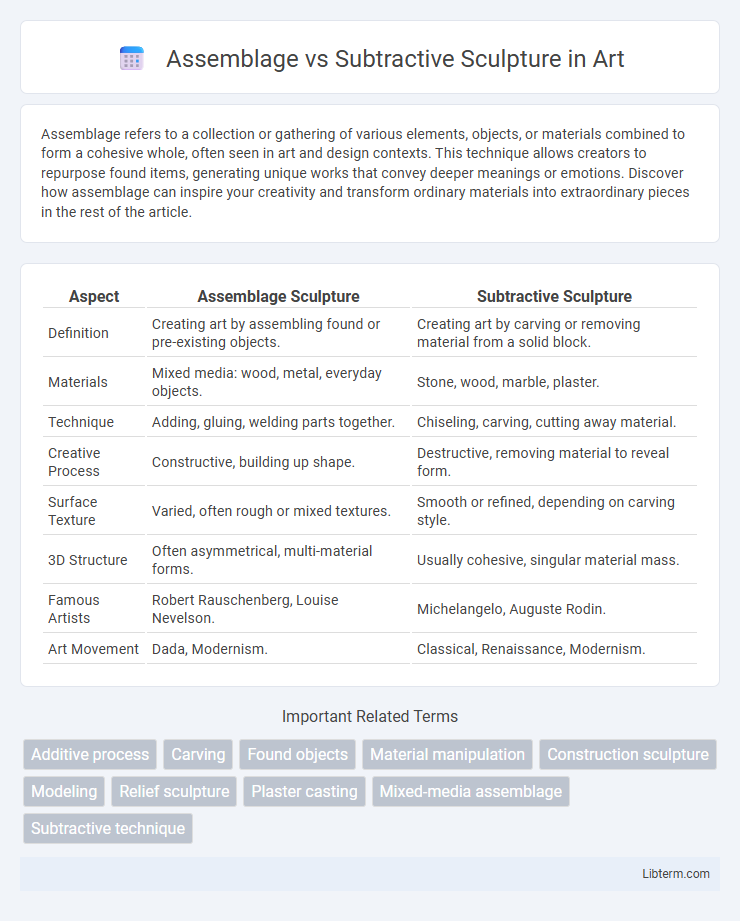Assemblage refers to a collection or gathering of various elements, objects, or materials combined to form a cohesive whole, often seen in art and design contexts. This technique allows creators to repurpose found items, generating unique works that convey deeper meanings or emotions. Discover how assemblage can inspire your creativity and transform ordinary materials into extraordinary pieces in the rest of the article.
Table of Comparison
| Aspect | Assemblage Sculpture | Subtractive Sculpture |
|---|---|---|
| Definition | Creating art by assembling found or pre-existing objects. | Creating art by carving or removing material from a solid block. |
| Materials | Mixed media: wood, metal, everyday objects. | Stone, wood, marble, plaster. |
| Technique | Adding, gluing, welding parts together. | Chiseling, carving, cutting away material. |
| Creative Process | Constructive, building up shape. | Destructive, removing material to reveal form. |
| Surface Texture | Varied, often rough or mixed textures. | Smooth or refined, depending on carving style. |
| 3D Structure | Often asymmetrical, multi-material forms. | Usually cohesive, singular material mass. |
| Famous Artists | Robert Rauschenberg, Louise Nevelson. | Michelangelo, Auguste Rodin. |
| Art Movement | Dada, Modernism. | Classical, Renaissance, Modernism. |
Understanding Assemblage Sculpture
Assemblage sculpture involves creating three-dimensional art by combining found objects and materials, often repurposed, without extensive carving or removal. This technique emphasizes the juxtaposition of diverse elements to convey meaning, contrasting with subtractive sculpture, which involves carving away material to reveal form. Understanding assemblage highlights its innovative and resourceful approach in contemporary and modern art practices.
What is Subtractive Sculpture?
Subtractive sculpture is a technique where the artist removes material from a solid block, such as stone, wood, or marble, to reveal the desired form. This method relies on carving, chiseling, or cutting away the excess to shape the sculpture, emphasizing precision and the permanence of the material. Unlike assemblage, which builds up by combining different elements, subtractive sculpture is inherently reductive and demands careful planning to avoid irreparable damage.
Key Differences Between Assemblage and Subtractive Techniques
Assemblage sculpture involves constructing artwork by combining found objects and materials, emphasizing additive processes to build form, while subtractive sculpture entails carving or removing material from a solid block, such as stone or wood, to reveal the final shape. Key differences lie in the approach: assemblage prioritizes accumulation and juxtaposition of diverse elements, whereas subtractive techniques focus on reduction and refinement of a single mass. This contrast influences both the creative process and the tactile qualities, with assemblage often producing mixed-media compositions and subtractive sculpture showcasing the material's inherent textures and forms.
Materials Used in Assemblage vs Subtractive Sculpture
Assemblage sculpture incorporates diverse found objects and non-traditional materials such as wood, metal scraps, paper, and fabric, emphasizing the combination and layering of disparate elements. Subtractive sculpture primarily involves carving and removing material from solid blocks of marble, stone, wood, or sometimes synthetic materials like plaster. The materials in subtractive sculpture are typically homogeneous and chosen for their durability and ability to hold detail, while assemblage sculptures rely on mixed media to create texture and conceptual layering.
Historical Origins and Evolution
Assemblage sculpture originated in the early 20th century, rooted in Cubism and Dada movements, with artists like Pablo Picasso and Marcel Duchamp transforming found objects into three-dimensional artworks. Subtractive sculpture dates back to ancient civilizations such as Egypt and Greece, characterized by carving away material from stone, wood, or marble to reveal the form within. Over time, assemblage evolved through modernist and contemporary art, incorporating diverse materials and conceptual approaches, while subtractive methods have remained central to classical sculpture traditions.
Notable Artists and Their Works
Notable artists in assemblage sculpture include Louise Nevelson, renowned for her monochromatic wooden wall pieces like "Sky Cathedral," and Robert Rauschenberg, who incorporated found objects in his "Combines." In subtractive sculpture, Michelangelo stands out for marble masterpieces such as "David," showcasing detailed carving from a single block. Auguste Rodin's "The Thinker" exemplifies subtractive techniques emphasizing texture and form through material removal.
Creative Process Comparison
Assemblage sculpture involves creating artworks by combining found objects or non-traditional materials through methods such as welding, gluing, or nailing, emphasizing additive creativity and spontaneous composition. Subtractive sculpture relies on carving or removing material from a solid block like stone, wood, or marble, demanding meticulous planning and precision to reveal the final form. The creative process in assemblage allows for more improvisation and collage-like experimentation, whereas subtractive sculpture requires a disciplined approach to uncover the intended shape within the raw substrate.
Impact on Modern Art Movements
Assemblage sculpture, characterized by combining found objects, challenged traditional aesthetics and fostered experimentation in Dada and Surrealism, influencing Abstract Expressionism by emphasizing spontaneity and material diversity. Subtractive sculpture, involving carving away material, reinforced classical techniques but evolved through Modernism by pushing limits of form and abstraction seen in Cubism and Minimalism. The contrast between additive and subtractive methods spurred innovative dialogues on space, texture, and conceptual expression, shaping 20th-century art movements' development.
Preservation and Longevity Considerations
Assemblage sculpture, created by combining found objects and various materials, often faces challenges in preservation due to the diversity of components, which may degrade at different rates and react adversely to environmental conditions. In contrast, subtractive sculpture, typically carved from durable materials like marble or stone, generally offers greater longevity and easier conservation, requiring less intensive maintenance. Preservation efforts for assemblage sculptures must account for the individual materials' stability and potential for chemical interactions, while subtractive works benefit from the inherent resilience of monolithic materials.
Choosing Between Assemblage and Subtractive Approaches
Choosing between assemblage and subtractive sculpture depends on the artist's intent and material constraints. Assemblage involves combining found objects, promoting creative freedom and allowing for diverse textures and forms, ideal for conceptual or mixed-media projects. In contrast, subtractive sculpture requires carving away material, demanding precision and planning, suited for traditional mediums like stone or wood where the form is revealed through removal.
Assemblage Infographic

 libterm.com
libterm.com